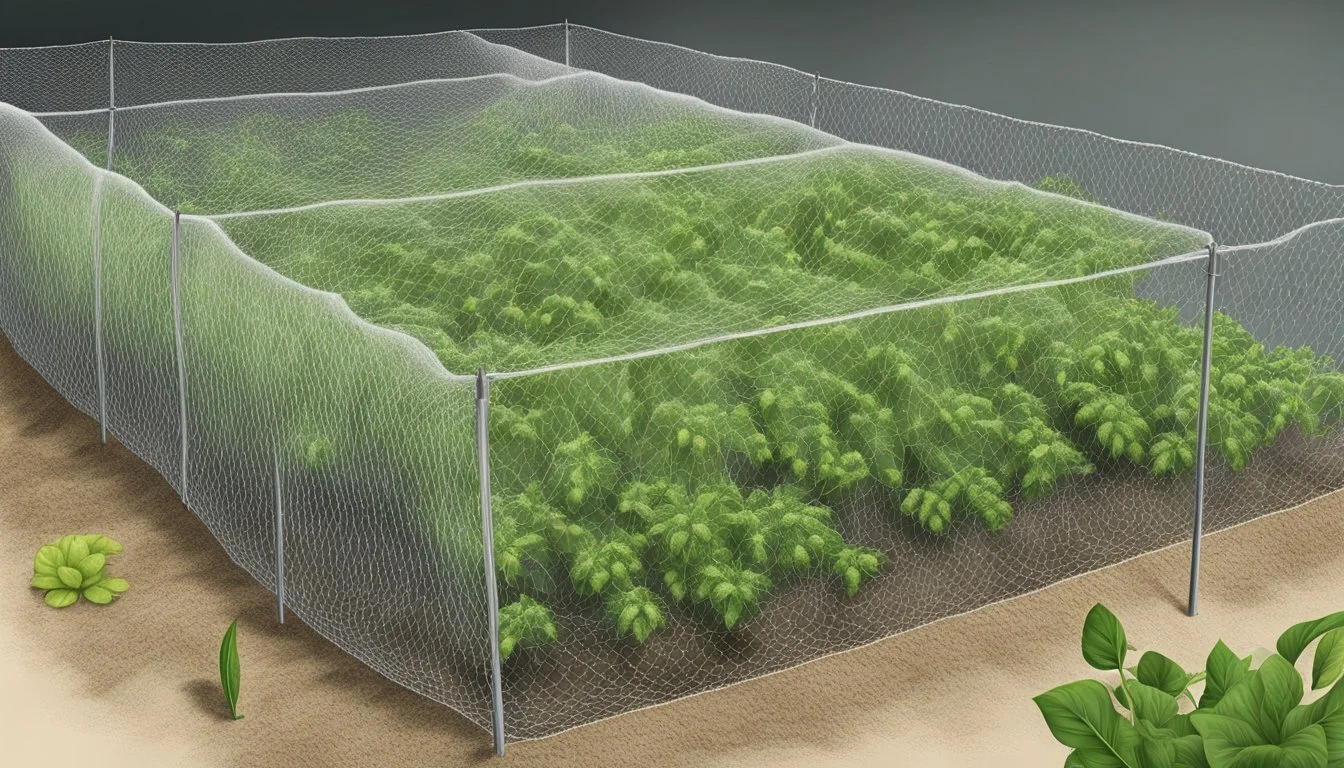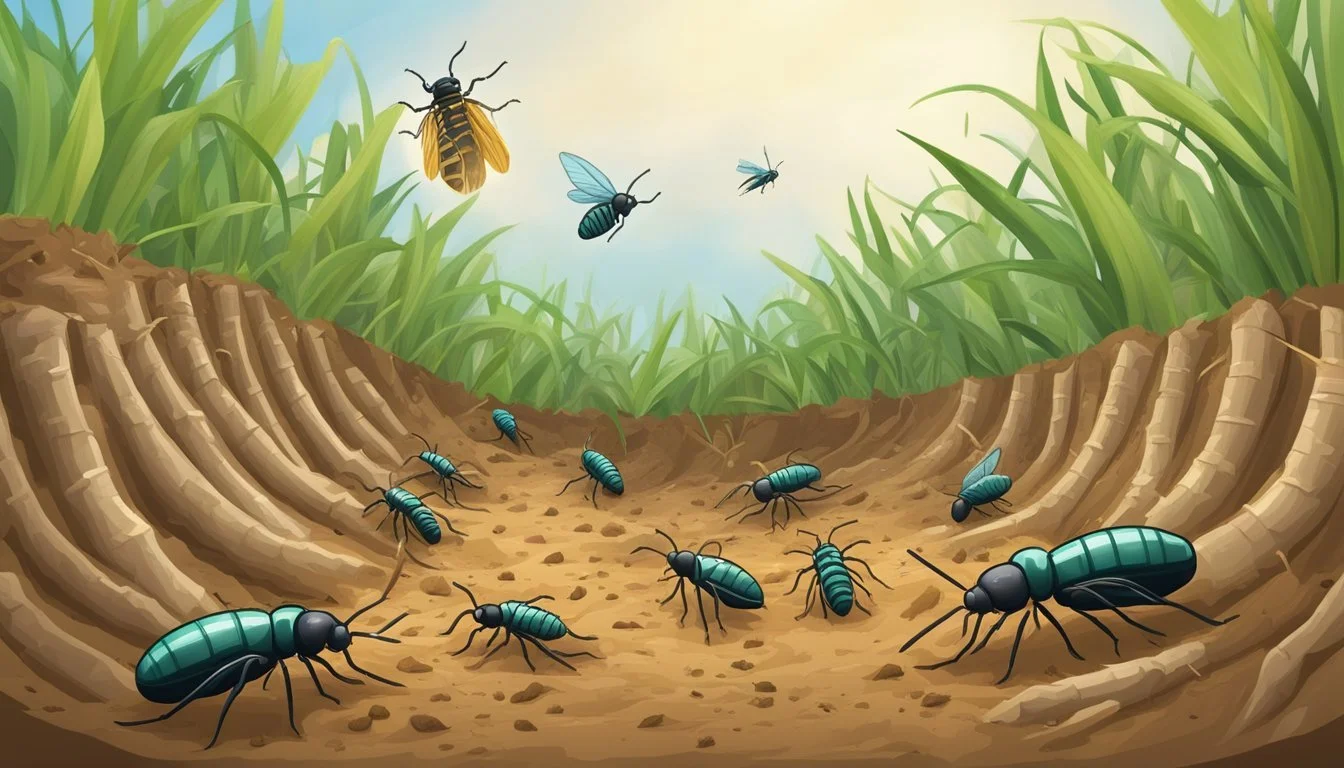Protecting Crops from Root Maggots
Effective Strategies for Prevention and Control
Root maggots are a pest that can cause significant damage to a variety of crops by attacking the roots and leaving plants vulnerable to disease and decay. These pests are particularly problematic for gardeners and farmers because once an infestation takes hold, it can be difficult to eradicate. Understanding the life cycle of root maggots is essential for effective prevention and control, as they typically go through a complete metamorphosis including egg, larva, pupa, and adult stages.
The larvae, which are the actual root maggots, target the underground parts of the plant, feeding voraciously and often causing irreparable harm. Their preference for the roots of cruciferous vegetables, such as cabbage and radishes, and other crops like onions, makes them a formidable threat to these plants. It is vital to take action during the early stages of the life cycle to prevent adult flies from laying eggs near the base of the plants. Learning to identify the warning signs of their presence, such as wilting or discolored leaves and stunted growth, can help manage root maggot infestations before they escalate.
To safeguard crops, employing preventative measures can be far more effective than trying to manage an active infestation. Strategies such as crop rotation, utilization of row covers to create a barrier against egg-laying, and the use of traps to monitor adult fly populations are often recommended. For a persistent problem, some may turn to biological control methods, such as introducing natural predators, or chemical pesticides as a last resort. Implementing an integrated approach that combines these methods can greatly reduce the likelihood of damage from root maggots.
Understanding Root Maggots
Root maggots are the larval stage of certain species of flies, recognized as a significant pest to a variety of garden and crop plants. These pests can cause extensive damage to roots and hinder plant growth, making understanding their lifecycle and habits essential for effective control.
Lifecycle and Biology
The root maggot lifecycle includes several stages: eggs, larva, pupa, and adult. Flies deposit eggs in the soil near the base of host plants. When eggs hatch, the larvae (root maggots) immediately begin feeding on root tissues. The larval stage can vary from a few days to weeks, depending on the species and environmental conditions. After feeding, these larvae enter the pupal stage where they transform into adult flies, completing one of potentially several generations a year.
Common Host Plants
Root maggots typically target cruciferous vegetables such as cabbage, radishes, and turnips. However, they are not exclusive and can infest other plants. These pests prefer plants with developing roots which supply ample food for the larvae.
Identifying Damage
To identify root maggot damage, one may observe wilting plants, stunted growth, and yellowing foliage. Upon closer examination, affected plants will often have tunnels or cavities within the roots where the larvae have eaten away the tissue. It is crucial to monitor for these signs, especially near the host plants they favor, to manage infestations promptly.
Critical Factors for Infestation
Understanding the critical factors that contribute to root maggot infestations is essential for protecting crops. These factors include environmental conditions that maggots find favorable and specific crop characteristics that increase susceptibility to infestation.
Favorable Conditions
Root maggots thrive in environments with certain soil, temperature, and moisture conditions. They are attracted to soil that is rich in organic matter which provides ample food for their larvae. Temperature is also crucial; root maggots often become active when soil temperatures reach approximately 8 degrees Celsius (46 degrees Fahrenheit). Moisture, as well, plays a significant role—excessive moisture or overly wet soils can attract these pests and create a conducive environment for their eggs to hatch.
Soil: High organic content.
Temperature: Around 8°C (46°F).
Moisture: High levels or damp conditions.
Plant Susceptibility
Certain crops are more susceptible to root maggot attacks, especially during specific growth stages. Young seedlings and seeds are particularly vulnerable as they provide an easy food source for the newly hatched larvae. Crops like turnips, radishes, and other root vegetables often bear the brunt of the infestation due to their fleshly roots that maggots feed on. The age of the crop also influences susceptibility, with younger plants being more at risk than mature ones.
Susceptible Crops: Turnips, radishes, cabbage.
Seeds and Seedlings: Increased risk during early growth stages.
Preventive Measures
To protect crops effectively against root maggots, gardeners and farmers can implement a variety of strategies. These methods, ranging from adopting certain agricultural practices to utilizing biological agents, thwart the infestation and safeguard the health of the plants.
Cultural Practices
Crop Rotation: Farmers maintain soil health and disrupt the life cycle of root maggots by planting different crops in a particular area each season. This practice prevents the pest from becoming entrenched, as root maggots often prefer specific host plants.
Soil Management: Careful management of crop residues is key, as root maggots can thrive in decaying organic matter. Removing or tilling under plant residues promptly after harvest can significantly reduce maggot populations.
Physical Barriers
Floating Row Covers: These act as a shield, physically preventing adult flies from laying eggs near the plants. Properly installed, floating row covers can create an effective barrier without hindering plant growth or the passage of light and moisture.
Sanitation: Eliminating potential breeding sites by keeping the garden clean of decaying vegetation and thinning seedlings can reduce the likelihood of attracting root maggot flies.
Biological Controls
Beneficial Nematodes: These microscopic organisms can be introduced into the soil where they naturally seek out and destroy root maggot larvae. They are a potent biological control method that can be used as part of an integrated pest management approach.
Biological Control Agents: Certain insects, such as predatory beetles, can feed on root maggot eggs and larvae. Encouraging or introducing these beneficial insects can help keep root maggot populations in check.
Monitoring and Detection
Effective monitoring and detection are critical steps in protecting crops from the detrimental impact of root maggots. These measures allow farmers to make timely and informed decisions regarding pest control.
Scouting and Signs
One should vigilantly scout for the presence of adult flies near crop fields, as they are precursors to potential root maggot infestations. Farmers need to watch for feeding damage symptoms such as wilted plants, reduced growth, and chlorotic (yellowing) leaves. Upon observing these signs, it's important to examine the roots for the distinctive tunnels caused by the larvae, which is a direct indication of root maggot activity.
Use of Traps
Sticky traps can be a reliable tool for monitoring adult fly activity. Placing them strategically near the crops, especially along the field edges, can intercept adult flies as they migrate. Monitoring these traps regularly provides insight into the population density and helps determine the necessity and timing of control measures. It is through the meticulous inspection of these traps that one can gauge the extent of the root maggot problem, allowing for more targeted and efficient management efforts.
For example, researchers at the University of Connecticut employed hot-cherry pepper plants as trap crops to attract and monitor pepper maggots, giving a practical illustration of using lure plants in conjunction with traps. Additionally, considering the life-cycle of the cabbage root maggot, setting out traps in early spring as adults emerge can be particularly effective as noted in a monitoring guide by Oregon State University.
Direct Control Methods
Direct control methods against root maggots involve applying specific measures that target these pests at critical points in their life cycle. Gardeners and farmers can take a proactive approach using chemical treatments and natural products to safeguard their crops.
Chemical Treatments
Chemical insecticides can be effective in controlling root maggot populations. Insecticides should be applied as a soil drench around the base of the plant to target the larvae. It is crucial to follow the manufacturer's instructions for application rates and timings to protect crops from root maggot damage effectively while minimizing environmental impact. Some active ingredients in pesticides known to combat root maggot infestations include chlorpyrifos and permethrin.
Natural Products
For those seeking environmentally friendly alternatives, natural products play a vital role in direct control methods:
Diatomaceous earth: This naturally occurring substance can be sprinkled around the base of plants. The sharp edges of diatomaceous earth's particles can deter adult flies from laying eggs and hurt the larvae trying to crawl over it.
Nematodes: Beneficial nematodes such as Heterorhabditidae or Steinernematidae can be introduced into the soil. These microscopic worm-like organisms specifically target and eliminate root maggot larvae without harming the plants.
Using these direct control methods can significantly reduce the presence of root maggots and protect crops from the damage these pests cause.
Managing Affected Plants
Once plants are affected by root maggots, a gardener must promptly address the damage to mitigate further loss. This involves direct strategies to rehabilitate the plants and modifying the soil environment to disrupt the lifecycle of the pests.
Rehabilitation Strategies
Firstly, inspection is critical; gardeners should carefully examine plants for signs of root maggot damage, such as root tunnelling or yellowing leaves. Pruning away the damaged roots and foliage can help the plant channel energy into new growth. If the plant displays signs of bacterial or fungal rot from damaged tissues, removing the affected areas is essential to prevent the spread.
Soil Treatment
Modifying the soil involves both immediate and long-term strategies. Immediate interventions may include applying diatomaceous earth around the base of plants, which can deter further maggot infestation. For long-term soil health, incorporating organic matter can boost beneficial microorganism populations that outcompete harmful bacteria and fungi. Additionally, nematodes that are natural predators to root maggots can be introduced to the soil to keep the pest population in check.
Frequently Asked Questions
The following questions cover essential strategies and methods for defending against root maggots, providing practical and effective solutions for gardeners and plant enthusiasts.
What natural methods are effective at controlling root maggot infestations?
Natural control methods for dealing with root maggots include the introduction of beneficial nematodes into the soil that prey on the maggots, and creating barriers with roofing tarpaper or toilet paper tubes to discourage egg-laying by the adult flies.
How can I identify root maggot damage in my plants?
Damage from root maggots manifests as wilting plants and yellowing leaves since the larvae feed on the roots. Infested plants may also appear stunted and can eventually die if the damage is severe enough.
What are the best practices for preventing root maggots in house plants?
Prevention of root maggots in house plants involves routine inspection of plants for signs of infestation, avoiding overwatering, and ensuring proper drainage to create unsuitable conditions for maggot development.
Are there organic pesticides available for radish root maggot control?
Organic pesticides, such as pyrethrin-based products, can effectively control radish root maggots. These pesticides must be applied with care and according to the manufacturer's instructions to ensure efficacy and minimize impact on beneficial insects.
How can diatomaceous earth be used to combat root maggots?
Diatomaceous earth is a natural powder that can be sprinkled around the base of plants. Its abrasive properties can physically damage the maggots, and it works by dehydrating them upon contact.
Can the presence of maggots in soil affect the health of my plants?
Maggots in the soil, specifically root maggots, feed on the roots of plants and can cause significant damage. Their presence can affect the plant's ability to absorb water and nutrients, leading to poor health and growth.



